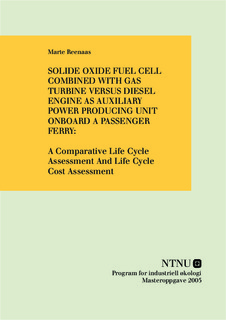| dc.contributor.author | Reenaas, Marte | nb_NO |
| dc.date.accessioned | 2014-12-19T12:34:50Z | |
| dc.date.available | 2014-12-19T12:34:50Z | |
| dc.date.created | 2007-02-26 | nb_NO |
| dc.date.issued | 2005 | nb_NO |
| dc.identifier | 122122 | nb_NO |
| dc.identifier.uri | http://hdl.handle.net/11250/242605 | |
| dc.description.abstract | A comparative Life Cycle Assessment (LCA) and Life Cycle Cost analysis (LCC) were performed to evaluate the environmental and economical performance of a solid oxide fuel cell combined with gas turbine (SOFC/GT) versus a conventional diesel engine as auxiliary power producing unit onboard a passenger ship. A setup of three diesel engines of 1080kW for the conventional system and five modules each of 500kW for the SOFC/GT system were investigated. Four different SOFC/GT fuel supply scenarios were studied, LNG from Norway, LNG from Import, onsite liquefaction of natural gas and sulphur free car diesel. The LCA includes the manufacturing of the auxiliary systems, operation and fuel supply and decommissioning (discussed qualitatively only), while the LCC includes purchasing cost, maintenance cost, energy costs and decommissioning cost (qualitatively). The vessel is assumed to service the route Oslo-Kiel.
Three environmental categories are included in the LCA: global warming potential, photochemical oxidation potential and acidification potential, calculated in CO2, CH4 and SO2 equivalents respectively. It is found that all SOFC/GT scenarios have a much better environmental performance than the conventional diesel engine in all the three environmental categories. The main advantages for the fuel cell systems are cleaner fuels and higher electric efficiency, compared to the conventional diesel engine. The most environmentally advantageous scenario is a fuel cell system using LNG (liquefied natural gas) produced in Norway. This is due to fewer and shorter fuel transport links.
Evaluation of the life cycle costs of the auxiliary systems identifies the diesel engine to be the cheapest alternative of the auxiliary systems. The SOFC/GT system using LNG from Norway or LNG imported via Kiel is the cheapest SOFC/GT system. Due to the high uncertainty concerning the costs different sensitivity analysis were performed. All LCC scenarios performed pointed out the fuel cell initial cost and stack replacement cost as the crucial cost disadvantages for the SOFC/GT system and low energy costs as a great advantage.
A hybrid model was created, using the total LCC results as an “economical category” combined with the emissions categories in the LCA. Such a hybrid model where the LCA and LCC are integrated requires that the importance of the environment and the economy are weighed when choosing an auxiliary system. In this case the conclusion is that the passenger ferry company has to choose whether it is willing to pay more per kWh for the SOFC/GT system than for the diesel engine, to achieve a distinct improvement of the environmental performance. | nb_NO |
| dc.language | eng | nb_NO |
| dc.publisher | Norges teknisk-naturvitenskapelige universitet, Fakultet for ingeniørvitenskap og teknologi, Program for industriell økologi | nb_NO |
| dc.title | Solid Oxide Fuel Cell Combined With Gas Turbine Versus Diesel Engine As Auxiliary Power Producing Unit Onboard A Passenger Ferry: A Comparative Life Cycle Assessment And Life Cycle Cost Assessment | nb_NO |
| dc.type | Master thesis | nb_NO |
| dc.contributor.department | Norges teknisk-naturvitenskapelige universitet, Fakultet for ingeniørvitenskap og teknologi, Program for industriell økologi | nb_NO |
